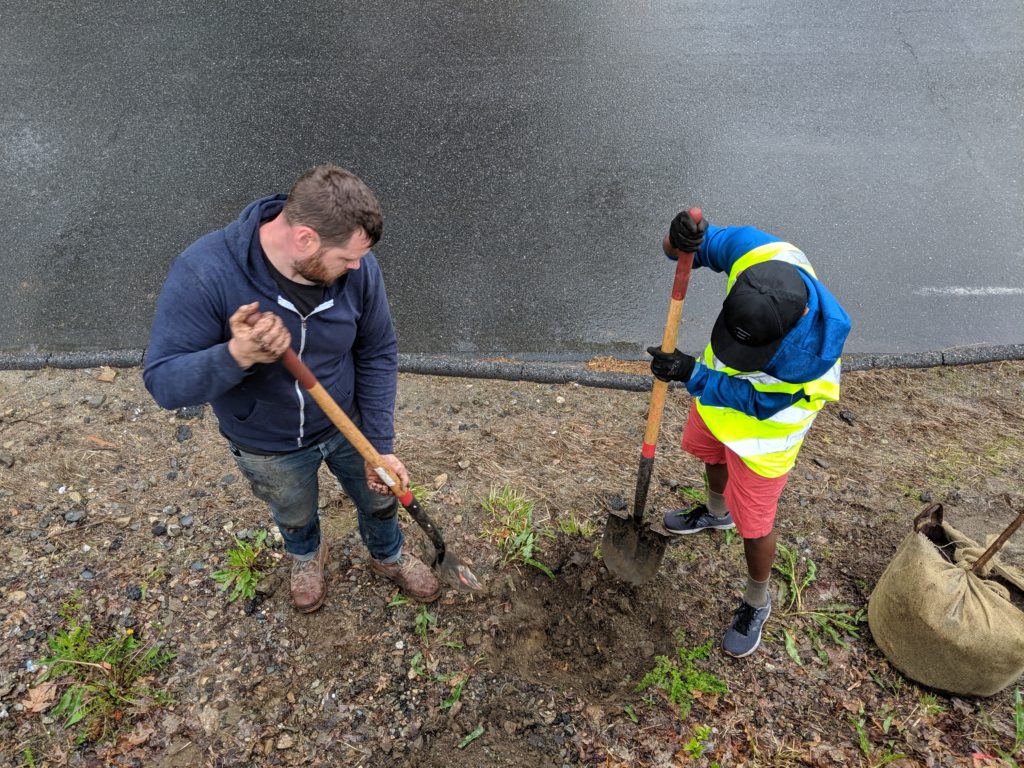
By Joel Mullen
At the beginning of the Master Tree Stewards training program I was unsure that my horticulture background would be of any use to the team. My background is bonsai trees. I have 48 (I just counted) and have been growing them for a little over 10 years. After a few years of volunteering with the Worcester Tree Initiative almost year round it is clear that the similarities between growing bonsai trees and caring for urban street trees are vast.
Many of the sidewalks and cramped planting locations for an urban tree are similar to a bonsai pot. The roots have a finite amount of space to take up and you need to find the right tree for that location. Bonsai trees need pruning in order to keep their form and the same goes for a street tree. Watering, in the early stages of a street tree’s life, is vital. In bonsai practice watering is one of the first skills that needs to be perfected. The transition from bonsai tree to urban street tree made instant sense.
When a bonsai tree becomes too large for it’s pot it has to be repotted. It’s a simple enough task for a tree that is a foot tall. However, when a tree becomes too large for its urban environment it has to be removed. Most crews will cut it down in an hour or two. Many of the large, well established trees growing around the city of Worcester are as old as the oldest citizens of the city. Over those trees live’s they have been touched by countless hands from countless departments of the city. They are planted, then watered, and later pruned several times before they are ready to grow on their own without the assistance of human caretakers. A whole lifetime of care and growing stopped in a moment.
That is part of the organism that is a city. Everything is constantly evolving in a city and its natural aspects are just as much a part of the city as the buildings and the people. A tree that is in the wrong place or is the wrong tree for the location has to be removed. One hundred years of natural beauty taken away just to appease some humans. It is a terrible thought but that is the only way a city can exist. As citizens of earth we constantly need to help mother nature recover from our bad decisions.
In the city of Worcester, when a new tree is needed, that’s when the Worcester Tree Initiative steps in. We have to figure out why that tree needed to be taken out. Was it sick? If so, what made it sick? Was it a foreign pest, poor soil quality, or a species of tree that doesn’t thrive in our environment? Maybe the tree was a species that grew too tall for it’s location. Was it an oak that was planted under telephone wires or too close to a building. It could have been a species that needs more or less sun than where it was planted. The possibilities are endless. Solving problems to benefit the people of Worcester and, at the same time, the natural environment of the city has been incredibly rewarding.
The main reason that WTI is so successful is Ruth Seward and Derek Lirange. They are the core of the Worcester Tree Initiative. They also noticed what a great fit my obscure background was for their program. So much so that they gave me the opportunity to teach bonsai classes at New England Botanic Garden at Tower Hill. Since then I have been teaching bonsai regularly at New England Botanic Garden at Tower Hill and have expanded to teaching about cacti and succulents as well. Teaching those classes has also opened the door to teaching regularly at New England Bonsai Gardens as well as giving demos at greenhouses throughout New England.
I was part of the first class to graduate from the Worcester Tree Initiative Master Tree Stewards Training Program at New England Botanic Garden at Tower Hill. The class was made up of a wide variety of people with all different backgrounds. Some were students pursuing horticultural or biology degrees and some were citizens of Worcester who wanted to give their free time to helping the environment that they live in. Many of the times that I’ve helped prune the trees of Worcester I am surrounded by Master Gardeners and incredibly talented landscape professionals. It would probably be intimidating if they weren’t
also some of the nicest people I’ve ever met.
One of the main points I try to put out there when I teach is to not get discouraged if you kill a tree. I don’t know of any bonsai professional who hasn’t killed, at least, a lot of trees. As long as you are trying your best and are paying attention to the tree then you will learn from it when it dies. You will know that tree needs more water, or more sunlight, or less fertilizer. The tree will tell you what it likes and what it doesn’t like and if it dies you can try again with another tree. We need people trying to help our cities trees and landscape evolve. When a tree dies in the city we need to figure out what caused it. We need people to pay attention to the trees because they will tell us why they are unhappy. We need to speak for the trees.
Joel Mullen is a bonsai artist and a Master Tree Steward for the Worcester Tree Initiative program at New England Botanic Garden at Tower Hill.
